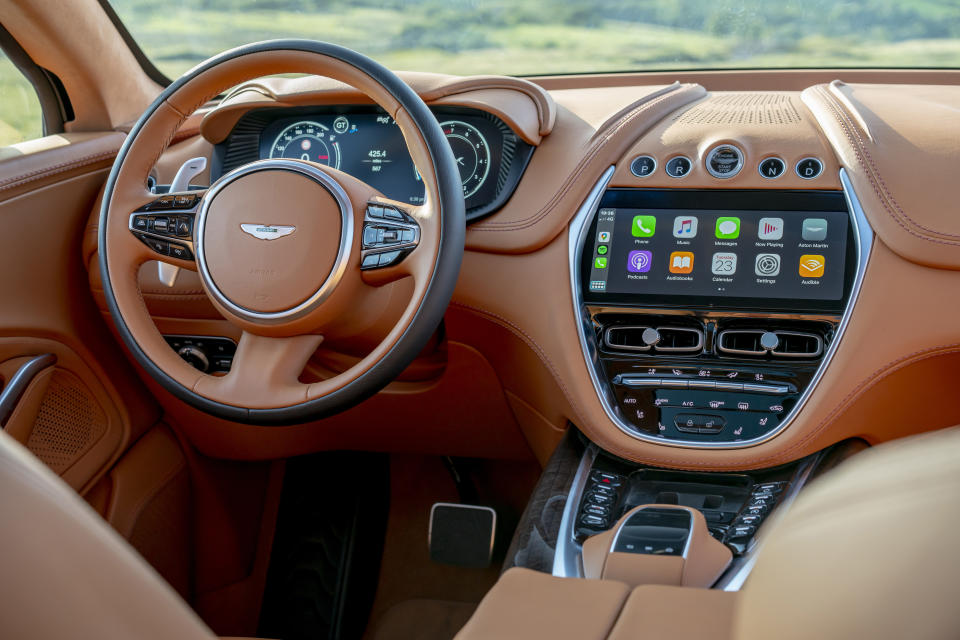Aston Martin is finally upgrading its stale infotainment system

When it comes to touchscreens and in-car entertainment, Aston Martin has not only lagged behind ultra-luxury rivals such as Lamborghini and Bentley, it has trailed lower priced tech-forward models as well.
Now, the automaker is preparing to catch up with a modern infotainment system that will be rolled out across its portfolio, starting this spring with the arrival of its next-generation of sports cars.
Historically, infotainment hasn’t been a high priority for makers of high-performance cars. That’s especially true for Aston Martin, an independent company with a small budget that gave precedence to performance and luxury touches, not dashboard displays.
“What you have to remember is, we are an independent brand,” Chief Creative Officer Marek Reichman told TechCrunch in a recent interview. “That has huge benefits and sometimes disadvantages as well, and we have to cut our cloth accordingly.”
Aston Martin is a public company with a majority of its shares owned by a consortium of investors that includes Mercedes-Benz and Canadian billionaire Lawrence Stroll, who joined Aston Martin as executive chairman in 2020.
The company doesn’t have the kind of financial backing that behemoths like Volkswagen AG, which owns both Lamborghini and Bentley, have access to. Instead, Aston Martin has relied for years on its partnership with Mercedes-Benz to provide the British brand with an older version of the software and operating system. The German juggernaut moved on from the COMAND system for its own models in 2018 in favor of its new MBUX infotainment.
“Mercedes gave us the reliability, but the user interface the consumer expects in the luxury market now has to go way beyond that,” said Alex Long, head of product and market strategy for Aston Martin. “I think it's always difficult for small manufacturers to develop market competitive solutions.”
Aston Martin is finally ready to swap its trackpad controls for touchscreens, a move most automakers made years ago.
The reason is twofold: The industrywide transition to software-based electric vehicles relies upon sophisticated dashboard electronics; meanwhile, progress is continually raising customer expectations for what an infotainment system should provide.
Aston Martin’s next-generation system features a “far more state-of-the-art” user experience and user interface, said Chief Creative Officer Marek Reichman. “With electrification, UX and UI is our price of entry.”
Daily drivers
The advent of the high-margin, often gas-guzzling ultra-luxury SUV segment has also forced the automaker to pay more attention to its entertainment and navigation capabilities.
The launch two years ago of Aston Martin’s first SUV, the DBX, exposed the brand to a new type of customer. Unlike track-based performance sports cars, SUVs are usually purchased as daily drivers focused on comfort and usability, including infotainment.
This year’s arrival of the high-performance DBX 707, named for its horsepower rating, exacerbated Aston Martin’s weakness relative to rivals. Though the SUV’s performance competes head-to-head with the ultra-quick Lamborghini Urus and Bentley Bentayga, the brand lost well-heeled shoppers who were less enamored with its outdated infotainment system.
Screen size
Still, Aston Martin customers shouldn’t expect to see domineering touchscreens, nary a button in sight. HVAC functions, for instance, will still use buttons, as will the drive mode selector in the center console.
“I think other companies have learned that if you put everything on the screen, it's really difficult,” Long said. “You don't just turn the wipers on; instead, you’ve got to press three times into a screen that’s really not that big.”
The automaker has not said how large its touchscreens will be, but Long said some will be larger than the 10.25-inch display in the DBX. Industrywide, screens have ballooned from Tesla’s original 15-inch iPad-like screen (then twice as large as other screens on the market) to the 56-inch display in the Mercedes-Benz EQS SUV.
“We're not focused on acres of screen,” Long said. “Because your eyeline is only in a certain area, you just want the navigation and primary controls. You don't want to be disrupted with something else from the other side of the car. So we're not going to give up all the dashboard real estate to screen.”
A luxury car should focus on the quality of the materials trimming its cabin, not the size of its screen, he added. That’s why the car company is retaining at least some old-fashioned knobs and buttons instead of controlling all functions via the touch screen.
“People expect the jewelry of the car,” Long said. “Our switches are milled from solid metal that’s cold to the touch, and that's part of the experience in the luxury sector. People love the smell of the leather, the touch of the cold switches in the morning. That’s part of the sensory experience that says, ‘I'm in my Aston today, and this is a nice place for me to sit.’”

 Yahoo Finance
Yahoo Finance 